The NVIDIA GeForce GTX 1080 Ti Founder's Edition Review: Bigger Pascal for Better Performance
by Ryan Smith on March 9, 2017 9:00 AM ESTPower, Temperature, & Noise
As always, last but not least is our look at power, temperature, and noise. Next to price and performance of course, these are some of the most important aspects of a GPU, due in large part to the impact of noise. All things considered, a loud card is undesirable unless there’s a sufficiently good reason – or sufficiently good performance – to ignore the noise.
| GeForce Video Card Voltages | |||||
| GTX 1080 Ti Boost | GTX 1080 Boost | GTX 980 Ti Boost | GTX 1080 Ti Idle | ||
| 1.062v | 1.062v | 1.187v | 0.65v | ||
Starting with voltages, there aren’t any big surprises with the GTX 1080 Ti. The underlying GP102 GPU has the same load voltages as the GP104 GPU in the GTX 1080, resulting in a load voltage of 1.062v.
Moving on, let’s take a look at average clockspeeds. The GTX 1080 Ti’s official base and boost clockspeeds are lower than the GTX 1080’s, but as we’ve seen before with other NVIDIA video cards, the actual clockspeeds are a little more variable and almost always higher than NVIDIA’s official values. Consequently the GTX 1080 Ti’s clockspeeds may on average trail the GTX 1080 less than what the specifications say.
| GeForce Video Card Average Clockspeeds | |||
| Game | GTX 1080 Ti | GTX 1080 | |
| Max Boost Clock |
1898MHz
|
1898MHz
|
|
| Tomb Raider |
1620MHz
|
1721MHz
|
|
| DiRT Rally |
1721MHz
|
1771MHz
|
|
| Ashes |
1680MHz
|
1759MHz
|
|
| Battlefield 4 |
1657MHz
|
1771MHz
|
|
| Crysis 3 |
1632MHz
|
1759MHz
|
|
| The Witcher 3 |
1645MHz
|
1759MHz
|
|
| The Division |
1645MHz
|
1721MHz
|
|
| Grand Theft Auto V |
1746MHz
|
1797MHz
|
|
| Hitman |
1657MHz
|
1771MHz
|
|
On the whole, the GTX 1080 Ti does average lower clockspeeds than the GTX 1080. Whereas the latter would frequently average clockspeeds in the 1700MHz range, the GTX 1080 Ti averages clockspeeds in the 1600MHz range. This, in part, is why NVIDIA is promoting the GTX 1080 Ti as being 35% faster than the GTX 1080, despite the card having a 40% advantage in total hardware units.
It is interesting to note though that our GTX 1080 Ti sample has the same maximum boost clock as the GTX 1080: 1898MHz. If the GTX 1080 Ti didn’t hit its thermal limit as often, it likely would come even closer to the GTX 1080 in average clockspeeds.
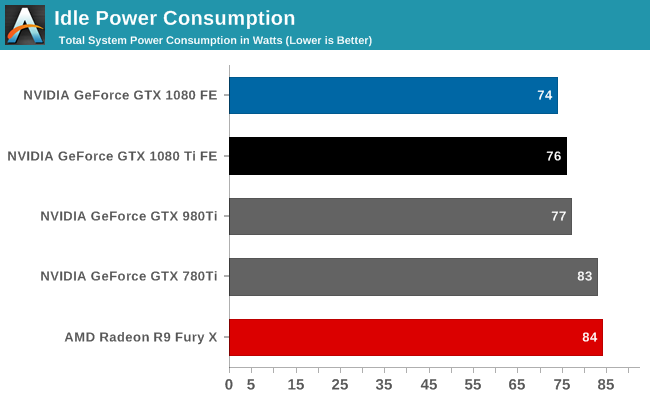
Moving on to power consumption, we’ll start as always with idle power. All told, there are no surprises here. GTX 1080 Ti’s idle power consumption is right next to GTX 980 Ti, which is where we’d expect it given the 250W design.
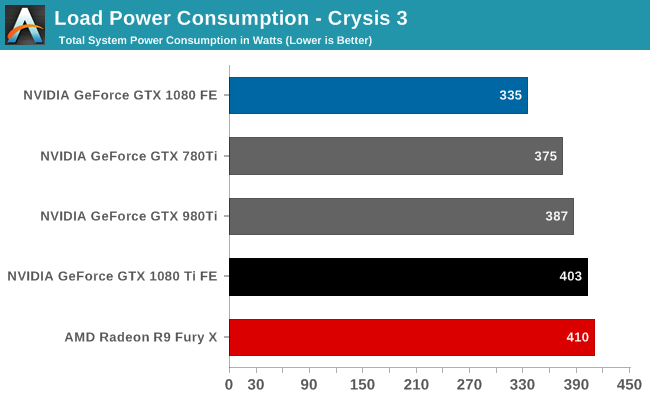
System power consumption under Crysis 3 is also right where we’d expect it to be for the GTX 1080 Ti. In absolute terms it’s second only to the R9 Fury X – which is to say that it’s high – but as Crysis 3 is a real-world test, power numbers here are influenced by the rest of the system. The faster the card, the more work required of the CPU, RAM, etc, and that’s exactly what’s happening here.
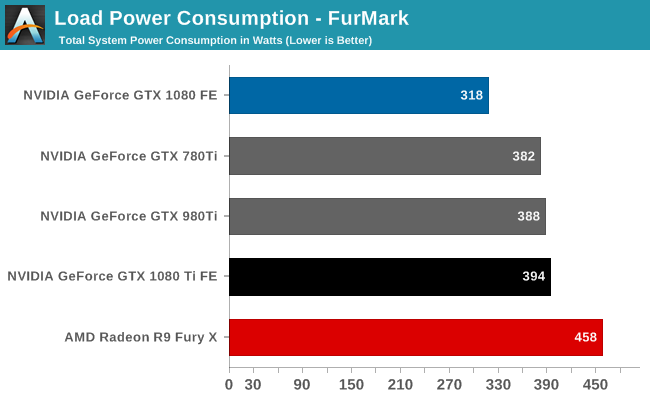
Switching over to FurMark, which is a much more GPU-focused test, we find that our GTX 1080 Ti-equipped testbed draws 394W at the wall. This is a smidge higher than the GTX 980 Ti, but not meaningfully so. All 3 250W NVIDIA cards are closely clustered together, showing that NVIDIA’s power throttling is working as expected, and at the levels expected. GTX 1080 Ti is rated for 70W higher than the GTX 1080, and our results back this rating up. With NVIDIA’s well-established power/performance tiers, GTX 1080 Ti makes the expected leap in power consumption in order to reach its loftier performance target.
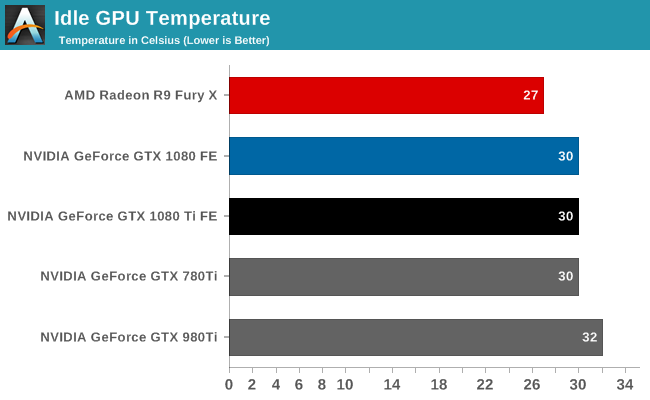
Moving on to temperatures, at idle the GTX 1080 Ti settles at 30C, the same as its siblings.
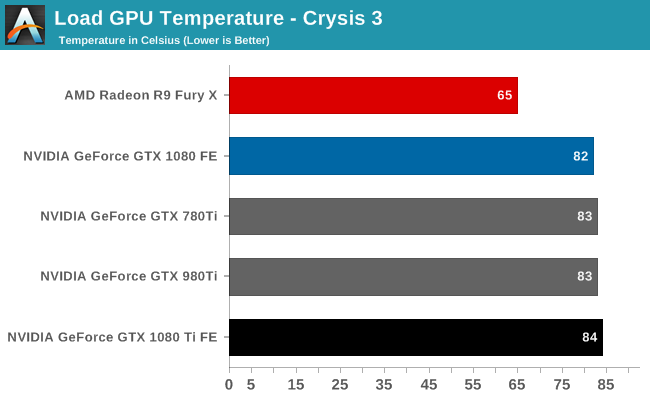
As for Crysis 3, the GTX 1080 Ti ends up being the hottest card here despite the cooling improvements, though it should be noted that this is intentional. While NVIDIA doesn’t publish this information directly, the GTX 1080 Ti’s preset thermal throttle point is 84C, which is a degree or two higher than on NVIDIA’s previous cards. As a result, the card reaches equilibrium at a slightly higher temperature than NVIDIA’s other cards.
It’s interesting to note that the throttle point has been slowly creeping up over the years; going back to the original Titan, it was only 80C. As far as reference specification designs go, the higher temperatures improve the efficiency of the cooler. The downside to higher temperatures is that power leakage increases with the temperature. So there’s a careful balancing act here in getting better cooling performance without drowning it out in more leakage-induced heat. In the case of the GTX 1080 Ti, I suspect NVIDIA paid their dues here with the additional MOSFETs, giving them a bit more headroom for leakage.
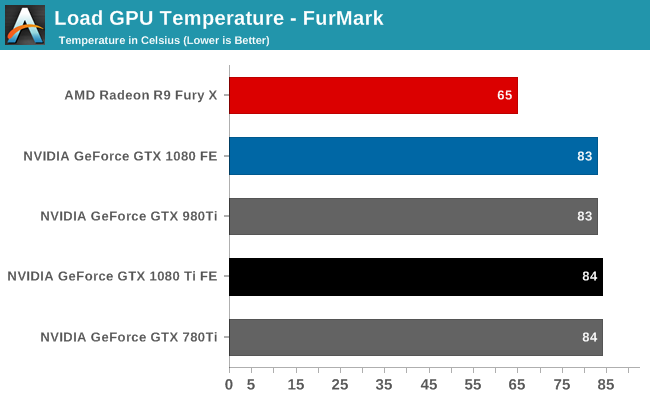
The story is much the same under FurMark. The GTX 1080 Ti settles at 84C here as well – though it did peak at 86C before reaching equilibrium – showcasing that regardless of the workload, the card always levels out at its thermal throttling point.
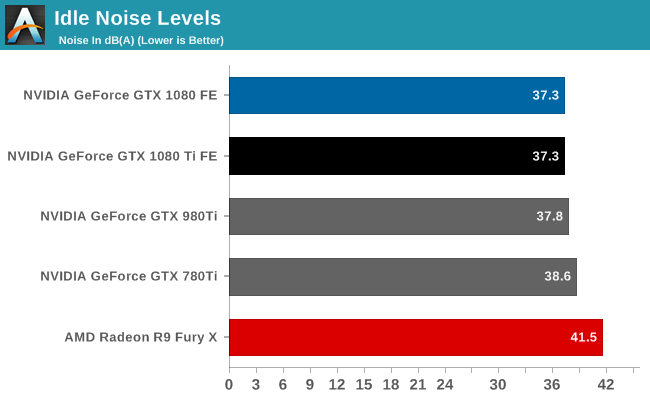
Finally we have our look at noise, starting with idle noise. Relative to the GTX 1080 NVIDIA has tweaked the fan curve a bit here, but at idle the GTX 1080 Ti is already below our noise floor.

Moving over to Crysis 3, we find that the GTX 1080 Ti holds a small edge over our other 250W TI-series cards. NVIDIA’s latest card hits 50.3dB, about 1.5dB below the GTX 980 Ti and GTX 780 Ti. This won’t make much of a difference, but it does close the gap between the 250W cards and the GTX 1080 by a bit.
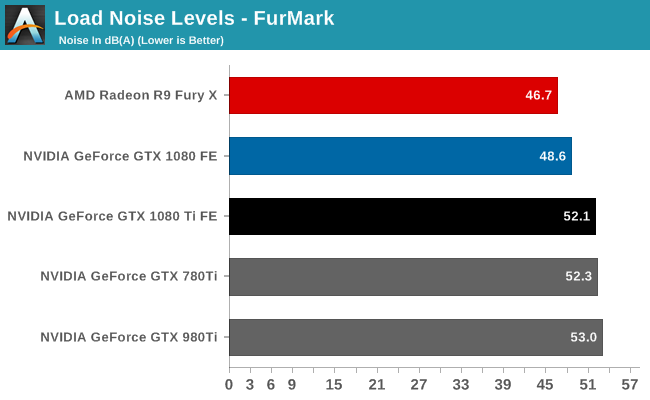
Finally, the situation with FurMark is much the same. The GTX 1080 Ti is still ever so slightly quieter than the other 250W NVIDIA cards, but a few dB louder than the GTX 1080.
Overall, judging from the power and noise characteristics of the GTX 1080 Ti, along with its throttling practices, it looks like NVIDIA invested most of their gains with the improved cooling system in removing more heat from the card itself. With few exceptions, the GTX 1080 Ti thermal throttles before it TDP throttles, and anecdotally, it tends to be closer to its TDP limit than most of the other high-end NVIDIA cards we’ve seen in the past couple of years.
Going back to what NVIDIA said earlier, they are claiming that the GTX 1080 Ti offers the largest performance uplift over its non-TI counterpart. Given that the TDP gap between the GTX 1080 Ti and GTX 1080 is actually smaller than the gap between the GTX 980 Ti and GTX 980 Ti – 70W versus 85W – if anything we’d expect this to be smaller. But by investing their gain from the improved cooler in better heat removal, NVIDIA is actually getting the GTX 1080 Ti closer to its performance/TDP limit than the previous generations of Ti cards. The only downside here is that you can only remove the DVI port once, so this isn’t an act that NVIDIA will be able to repeat in the next generation.










161 Comments
View All Comments
ddriver - Friday, March 10, 2017 - link
Yeah, also amd was free to offer discounts to those who didn't sell intel products. They helped make two games, and gave Larry who only sells amd systems a free amd t-shirt as a reward. Because that's what amd can afford, after years of being sandbagged by intel and Hecktor made it buy ati for 3 times what it was worth so it can go bankrupt so it will be forced to sell its fabs to Hecktor's arab boyfriends.eddman - Friday, March 10, 2017 - link
You did not answer the question.Being known in the industry for many years, yet nothing has happened.
ddriver - Friday, March 10, 2017 - link
What nvidia does is the same thing as lobying. It is legalized bribe. You cannot give a briefcase of money to a politician and tell him to do what you want him to. But you can spend a briefcase of money to make a politician do what you want him to do. And it is not illegal, politicians have legalized it, and as far as they and the lobbyists are concerned, that is a good thing, a political contribution.The same kind of advantage that allows nvidia to do that is what would give them the upper hand in court. It could be proven to be a crime, if only amd had enough money to out-sue nvidia. Which they don't. And if they did, they'd be able to support game developers, so it wouldn't even come to that. nvidia is friends with the big boys, amd is a perpetual underdog. In such scenarios, even if a lawsuit was to take place, it would be mostly a show for the public, and if found guilty, the punishment would be a symbolic and gentle slap on the wrist.
Now, with your question answered, do you feel better?
ddriver - Friday, March 10, 2017 - link
There is high likelihood that we will see such a case against nvidia, but not until they have completely cemented their dominance position, and that case would only serve to wipe nvidia clean, so they can enjoy their dominance without being haunted by their past of sleazy illegal practices, giving them a clean slate at a very desirable price.eddman - Friday, March 10, 2017 - link
So it is not illegal to help devs doing optimizations?ddriver - Friday, March 10, 2017 - link
It can be as legal or illegal as killing people. What nvidia does is most certainly unfair business practices and abuse of its position.The legal system is rarely about what is right or wrong. What nvidia does is certainly wrong. If they can get away with it, it is legal. If someone kills your entire family and then walks free because the legal system found him to be innocent, would you be as OK and defending his innocence as you are doing for nvidia?
eddman - Friday, March 10, 2017 - link
That comparison isn't even remotely relevant.Companies work with devs in the entire computing industry all the time to make sure software works best with hardware. It has never been illegal.
ddriver - Friday, March 10, 2017 - link
Are you by a chance on the spectrum? There is nothing wrong with helping to optimize software. For the last time - what is wrong is offering that help on implied exclusive terms. I don't know people who have been offered support by amd in exchange of sandbagging nvidia. But I know people who eventually optimized for amd and as a result lost the support nvidia offered prior to that. And the revenge didn't end there either, subsequent driver releases significantly worsened the performance of the already nvidia optimized code.nvidia doesn't help out of the kindness of their hearts or awesomeness, they do not even help to make the best out of their hardware, they only help if that would get them an unfair advantage, so it is implied that their help is only available to those who leave the amd rendering pipeline deliberately unoptimized.
eddman - Saturday, March 11, 2017 - link
...and some other people tell otherwise. Who to believe. Can you provide anything solid to back that up?"subsequent driver releases significantly worsened the performance of the already nvidia optimized code"
Which games? Which drivers? This one can be tested.
Why would nvidia reduce the performance of a game on their own cards, which is going to hurt them? The whole purpose of this was to make the game work best and sell cards based on that.
eddman - Saturday, March 11, 2017 - link
What about you? Are you on the spectrum?